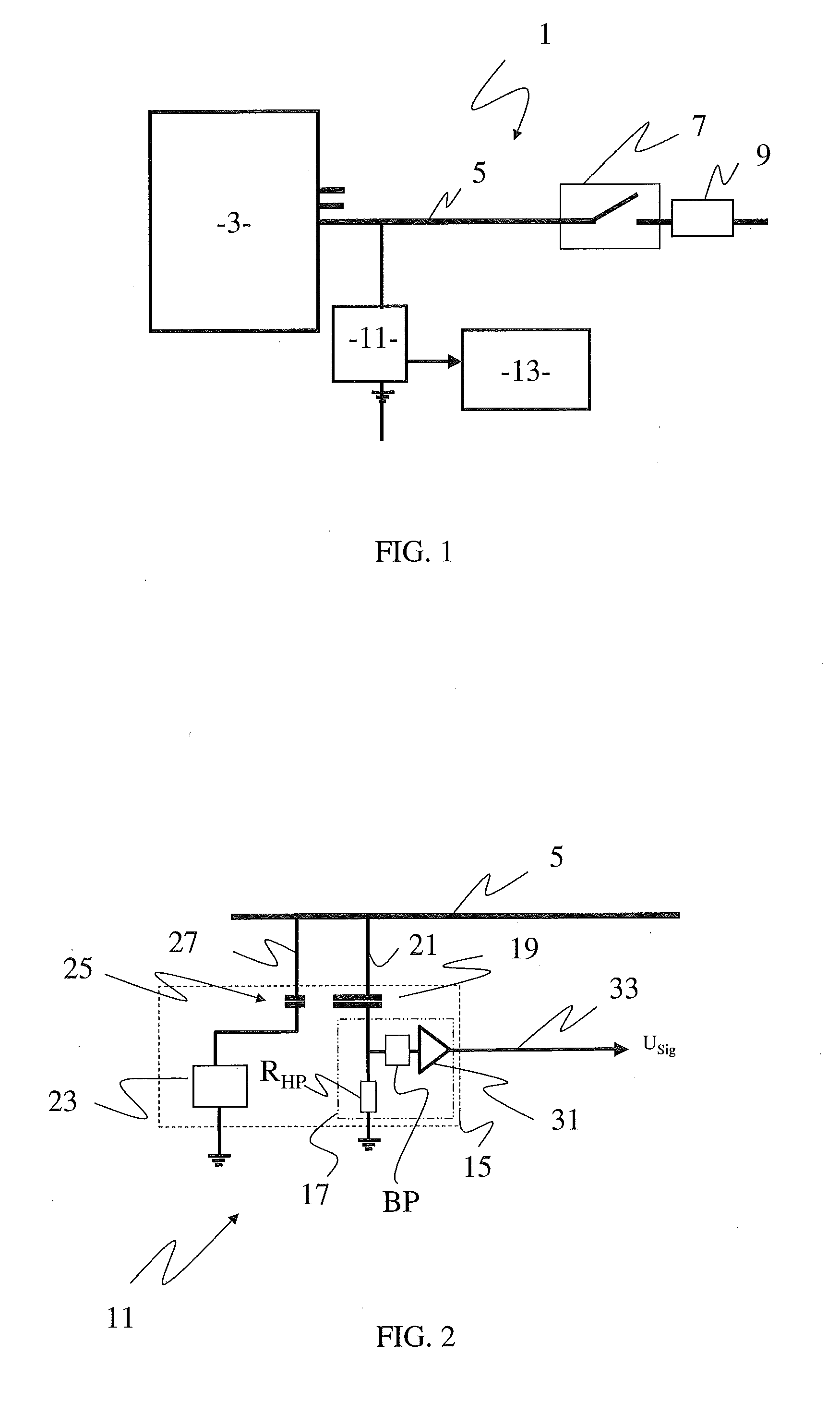Partial discharge sensor for a high voltage insulation monitoring device
a monitoring device and sensor technology, applied in the direction of testing circuits, air break switches, instruments, etc., can solve the problems of affecting the calibration precision, the only use of classical calibration devices off-line, and even breakdown
- Summary
- Abstract
- Description
- Claims
- Application Information
AI Technical Summary
Benefits of technology
Problems solved by technology
Method used
Image
Examples
second embodiment
[0046]FIG. 3 shows a partial discharge sensor 11 which differs from the embodiment of FIG. 2 only by the fact that the second high voltage conductor 27 is connected within the housing 15 to the first high voltage conductor 21. Therefore, there is only one high voltage conductor 21 to be connected to the high voltage line, the bus duct 5, meaning that the installation of the partial discharge sensor 11 is the same as those already used.
[0047]As could be seen on FIGS. 2 and 3, the coupling capacitor 19 and the calibration capacitor 25 are two distinct capacitors.
first embodiment
[0048]In order to gain in construction space, it is foreseen to realize both capacitors 19 and 25 as one constructive unit, as a dual capacitor unit 35 as shown for example in FIGS. 4A and 4B which are a schematic representation of a dual capacitor of the partial discharge sensor according to a
[0049]The dual capacitor 35 comprises a hollow cylindrical shaped isolator 37, in particular with a bottom 37A, cylindrical side walls 37B, a top wall 37C that has a connection chimney 37D. The isolator may have a wall thickness of 5 mm, a height of 5 cm and an outer diameter of 5 cm and can be made of a plastic composite.
[0050]Also shown are the high voltage conductors 21 and 27 which are traversing the chimney 37D and that are connected respectively to the high voltage part electrodes 19A of coupling capacitor 19 and 25A of calibration capacitor 25.
[0051]These electrodes 19A and 25A are located on the inner side of the hollow insulator 37. On the opposite side of the walls 37A and 37B, on th...
third embodiment
[0058]In FIG. 5 is shown a schematic representation of the partial discharge sensor 11 according to a
[0059]This embodiment differs from that shown in FIG. 3 by the fact that on the high voltage side, the coupling capacitor 19 and the calibration capacitor 25 have a common electrode 41.
[0060]This embodiment can be realized in slightly modifying the dual capacitor 35 shown in FIG. 4A.
[0061]Such a modified dual capacitor 35 is shown in FIGS. 6A and 6B which are a schematic representation of the dual capacitor of the partial discharge sensor according a second embodiment.
[0062]The dual capacitor 35 in FIG. 6A only differs from that shown in FIG. 4A by the fact that there is only one common high voltage conductor 43, replacing conductors 21 and 27, and that the high voltage electrodes 19A and 25A on the inner side of the isolator 37 are joined to form a common high voltage electrode 41.
[0063]Even with a common electrode 41, the surfaces of the electrodes 19B and 25B are chosen in such a ...
PUM
 Login to View More
Login to View More Abstract
Description
Claims
Application Information
 Login to View More
Login to View More - R&D
- Intellectual Property
- Life Sciences
- Materials
- Tech Scout
- Unparalleled Data Quality
- Higher Quality Content
- 60% Fewer Hallucinations
Browse by: Latest US Patents, China's latest patents, Technical Efficacy Thesaurus, Application Domain, Technology Topic, Popular Technical Reports.
© 2025 PatSnap. All rights reserved.Legal|Privacy policy|Modern Slavery Act Transparency Statement|Sitemap|About US| Contact US: help@patsnap.com



